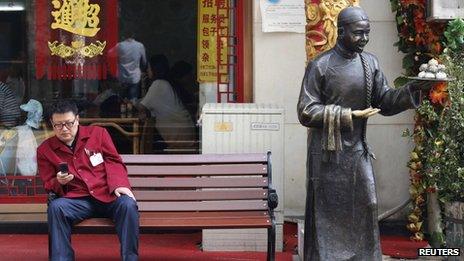The Chinese balancing act
- Published
- comments

In economics, as in life, it's all about balance.
Balance is what we all want - a little more sleep and a little less stress. For countries, it is about having a diversified economy with a large set of engines to generate growth.
It's less stressful than relying on, say, just the consumer. Western countries have done that with varying degrees of success. But the world's second largest economy, China, has already seemingly achieved a better balance.
For the West - including the United States and the UK - the rebalancing of the economy refers to cutting back on consumption (which has been paid for by incurring debt that proved unsustainable), producing more and reversing the decline of manufacturing.
It also includes a desire to export more, tapping into new buyers in overseas markets so there's less reliance on the consumer at home.
But for China, it's the opposite. Rebalancing its economy means raising consumption and reducing its reliance on exports.
For the same reason that the West is looking elsewhere, China - already the world's largest trader - isn't counting on crisis-hit US or European consumers to the same extent as before. Instead, after 30-plus years of strong growth, Chinese consumers are in a better position to support the country's own businesses.
Watch: China is seeking to rebalance its economy away from industry and towards the service economy. Linda Yueh reports.
Growing services
It's not straightforward. China has tried for some time to develop its domestic market and rely less on manufacturing and exports.
In its 11th Five Year Plan that spanned 2006-2010, the Chinese government aimed to increase the service sector (shops, education, insurers, etc.) to closer to 50% of GDP - the level seen in other countries at a similar stage of development.
But the reality was that services languished at around 40%. After the 2008 financial crisis, when global exports collapsed, an estimated 20 million factory workers lost their jobs in China. This is the type of scenario which could generate the instability that China wants to avoid.
The government renewed its efforts to boost the domestic market, including the services sector. Services have large parts that are not geared at overseas sales - most people get their hair cut locally, for example.
The initial results are promising. In the first three months of this year, the largest part of the economy was services - not manufacturing - according to the Chinese National Bureau of Statistics.
Services accounted for a record 47.8% of GDP, overtaking industrial output at 45.9% for the first time. The figure for industry includes construction, so it certainly highlights how significant the service sector has become.
To be clear, it isn't because factory output is shrinking; in fact, industry has expanded from 45.3% of GDP in 2012. It is just that services grew more rapidly from less than 45% last year.
Instead it's the agricultural sector that has shrunk from just over 10% of GDP in 2012 to 6.3%.
These are first indications and time will tell how lasting this shift is, but it has already raised concerns.
Finding that balance
One worry expressed to me about rebalancing towards services and focusing on consumers came from one of China's best-known economists and the former World Bank chief economist, Justin Yifu Lin of Peking University.
He stresses that consumption should not be pursued for its own sake. The bursting of the credit bubble in America makes that point vividly. Instead, he says, consumption supported by income growth, not borrowing, is key.
He also points out that it's not exports which are the important factor for future growth, but more government spending and investment for productive uses.
Watch: Former World Bank chief economist, Justin Yifu Lin of Peking University, tells Linda Yueh that China still has potential for growth.
It's all about finding the right balance. China's economy is now fairly equally driven by services and industry, while maintaining its position as the world's largest exporter of goods. Manufacturing is growing and not declining. China is not giving up on exports, it's simply becoming more balanced.
It's one of the warnings stemming from the 2008 financial crisis. For most countries, the manufacturing share of the economy (not counting construction, resources, utilities) peaks at around one third of GDP.
Maintaining that sector has helped countries like Germany to avoid some of the imbalances plaguing the US and UK, where manufacturing has declined to closer to 10% of GDP.
Rebalancing the world?
For China, growth may slow from the nearly 10% rate of the past three decades - since services may not be as big an engine as industrialisation and the economy needs further reform.
But this growth may prove to be more stable. This is particularly an issue as inefficient investment, including in construction, could drag down the banks.
Importantly, services (unlike manufacturing) depends less on machines, but requires workers - ranging from high-end professionals to less-skilled staff.
This shift, along with slower growth of the labour force, may help explain the lack of significant unemployment even as the economy last year grew at 7.8% - the slowest pace for the 13 years since the Asian financial crisis.
Despite that slowdown, China exceeded its employment target of creating nine million jobs by over 33%. Over 12 million jobs were created in 2012.
And developing China's market for services could be beneficial for global businesses seeking new sources of demand. This would especially be the case for the world's biggest exporters of services, the US and the UK, who are both seeking to rebalance their economies toward exports.
With China's service economy becoming more established, the world may even become better balanced.